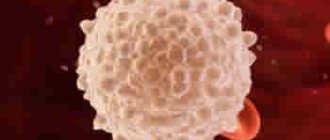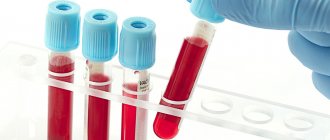Leukocyte esterase in urine - what does it mean?
This substance is a hydrolytic enzyme that is present in the cavity of lymphocytes and is involved in the processes of phagocytosis (intracellular breakdown of absorbed bacterial agents).
If the urine test is not stored and transported correctly, leukocytes can quickly be destroyed. If the sample was not transported and transferred within 3-4 hours to a special container containing a special preservative that prevents the destruction of leukocytes in a urine test, then the results obtained may be distorted. At the same time, the number of leukocytes drops sharply, which significantly affects the diagnosis.
A specialist may miss serious pathologies of the urinary system or make a false diagnosis, which will lead to inappropriate treatment. This can only contribute to the further development and progression of the pathology.
The enzyme leukocyte esterase can be detected even if leukocytes are destroyed in urine suspension. The level of this substance in the urine clearly indicates the activity of white blood cells in the urinary system. The presence of leukocyte esterase in a urine test indicates the development of an inflammatory process in the structures of the urinary system. This may indicate the development of various pathologies in the kidneys, ureters, bladder, and urethra.
What is leukocyte esterase?
Urine analysis allows us to learn a lot about the nature of the disease. Leukocyte esterase is an enzyme produced during the fight of leukocytes against infections of various types.
If urine tests reveal the presence of leukocyte esterase, this indicates that there is inflammation in the body that it is fighting. Leukocytes (white blood cells) move along the bloodstream, penetrating all organ cells.
When foreign elements are detected, they absorb them, thereby destroying pathogens. After this, they die and are excreted from the body in urine. Thus, leukocytes act as protectors of the body.
Checking urine for the presence of leukocytes reveals diseases of the genitourinary system. If the rules for storing urine are violated, the number of white blood cells is destroyed and reduced.
What causes distorted research results. Leukocyte esterase is an indicator that is not subject to change; its increased content indicates the presence of leukocytes, and therefore an inflammatory disease of the genitourinary organs.
The localization of the inflammatory process is indicated by the diagnostic results:
- the presence of leukocytes in kidney cells with one nucleus indicates the presence of inflammation in the kidneys;
- their detection in cells with two nuclei is evidence of urinary tract disease;
- traces of fatty inclusions in leukocytes indicate dystrophic changes in the kidneys, infections, and metabolic disorders.
One way to test urine is through dipstick testing. They go down into the urine. A change in the color of the strip indicates an increased content of white blood cells.
Decoding and indicators of the norm
Deciphering the received data is not difficult. The analysis of information and calculations is carried out by a laboratory diagnostics doctor or laboratory assistant. After assessing the information received, the specialist draws conclusions and makes a diagnosis or prescribes additional examination methods.
The second option is more common, because An increased amount of leukocyte esterase in the urine can occur in many pathologies and even in some cases be a variant of the norm. Normally, the number of leukocytes in the urine in men is from 0 to 3 in the visual field, and in women – 0-6 in the visual field. If traces of leukocyte esterase are detected in the analysis, laboratory assistants give one or more pluses (+) depending on the amount of this enzyme. This indicates the severity of the infection.
Leukocyte esterase in a woman's urine
The presence of leukocyte esterase in urine is examined using test strips. Upon completion of the analysis, set 1, 2 or 3 +:
- + indicates that an inflammatory process is most likely occurring in the organs of the genitourinary system, but it is mild;
- ++ - the infectious-inflammatory process is more intense. It may include several organs or structures at the same time;
- +++ - an indicator of a high concentration of leukocytes (exceeds 500 cells per 1 μl of urine).
Leukocyte esterase during pregnancy
What to do if leukocyte esterase is positive during pregnancy? During pregnancy, there is often an increase in the total number of white blood cells in the mother's body and their migration to the uterus, so increased levels of leukocytes and leukocyte esterase in the urine can be observed during pregnancy.
If other research methods do not confirm the presence of a bacterial infection in the body, then this is one of the normal options. Doctors call this condition sterile pyuria.
Leukocyte esterase in the urine of a child
The content of leukocytes in the urine of infants is normally slightly higher than that of adults. It can reach 1-8 cells in the field of view. The level of traces of leukocyte esterase in the child’s urine is up to 1 + normal.
Why is leukocyte esterase elevated during pregnancy?
A pregnant woman can judge the presence of an increased number of leukocytes by the color of her urine: it becomes cloudy and dark, and a mucous, loose sediment precipitates in the urine. Such tests indicate an increased level of leukocytes, and if emergency methods are not taken to detect the source of the disease, a threatening condition - leukocytosis - may develop.
It is possible to identify a particular disease that provokes an increase in the quantitative composition of leukocytes in the urine after additional tests, which the doctor will prescribe for the pregnant woman in case of “bad” tests. Often, an increased number of leukocytes accompanies inflammatory processes of the genitourinary tract.
This could be, for example, cystitis or bladder problems. Once the presence of just such problems is established, the pregnant woman will have to undergo a course of treatment - for cystitis it averages about 10 days. Timely cured cystitis, and its treatment itself, do not pose any danger to the fetus.
Another extremely unpleasant disease, which is accompanied by an increase in the number of leukocytes, can be candidiasis, or thrush. This disease occurs in pregnant women much more often than in other women, and usually appears in late pregnancy.
An increased number of leukocytes in the urine may also indicate problems with the kidneys in a pregnant woman: pyelonephritis is often one of the dangerous diseases that provokes this situation. The treatment of this disease must be approached with the utmost seriousness, and it is advisable to begin treatment immediately, at the initial stage.
In each individual case, after the detection of any disease, treatment for pregnant women is prescribed on an individual basis. Treatment will depend on the duration of pregnancy and the sensitivity of the pathogen to drugs. It also happens that it is impossible to determine the pathogen, or local treatment does not give the desired effect.
In this case, pregnant women are prescribed antibiotic therapy according to a standard regimen, taking into account the duration of pregnancy. For many expectant mothers, prescribing a course of antibiotics causes some dissatisfaction and anxiety. Some even voluntarily refuse antibiotic treatment, fearing the negative effects of medications.
It is worth noting that refusal of medications and ongoing inflammatory processes in the body can cause both mother and fetus much more damage than adequate treatment. A disease that progresses in the body of the expectant mother can cause pregnancy complications, including its termination.
In women, the level of leukocytes in the urine during pregnancy increases. Since the female body during this period is configured to protect the fetus, in case of danger, white blood cells rush to the dangerous area to neutralize the infection.
This results in a positive reaction to leukocyte esterase. The presence of pathology in the urinary system will be confirmed if a urine test shows an increased level of leukocytes.
The female body undergoes changes during pregnancy. The fetus puts pressure on the uterus, which increases the load on the walls of the bladder. Stagnation in it due to a decrease in muscle tone causes an inflammatory process that requires immediate treatment.
In pregnant women, an increased number of white blood cells is observed in the absence of inflammation, as the female body is reconstructed during this period. And if the cause of positive esterase lies in an inflammatory disease, then the woman is referred for further examination. Expectant mothers are obliged to take care of their health in order to give birth to a healthy child.
Reasons for deviations
Main article: Causes of elevated leukocytes in the urine of a child, norms
There are many reasons leading to the appearance of an increased number of leukocytes in the urine (leukocyturia). These mainly include infectious inflammatory processes of the urinary system. Because Any bacterial lesion is normally accompanied by activation of the cellular component of the immune system, then it will be manifested by an increased level of leukocytes or their enzymes (leukocyte esterase) in a urine test.
With bacterial damage to the urinary system, the level of leukocytes in the blood test increases significantly. Phagocytic leukocytes (those leukocytes that have absorbed and processed bacterial agents), no longer capable of the subsequent process of phagocytosis, are excreted from the body in the urine.
Diseases in which there is a significant increase in the level of leukocyte esterase in a urine test:
- Cystitis (inflammation of the bladder);
- Urethritis;
- Pyelonephritis;
- Interstitial nephritis;
- Prostatitis of infectious origin;
- Tuberculosis of the kidneys and urinary tract;
- Urolithiasis, etc.
An excessively pronounced increase in the number of leukocytes and leukocyte esterase in the urine is observed with:
- Hydronephrosis;
- Purulent pyelonephritis.
Also, an increase in leukocyte esterase in the urine may indicate:
- Development of the initial stage of glomerulonephritis;
- Nephritic syndrome;
- Presence of urogenital infection;
- Severe fever;
- Chronic renal failure, etc.
Results table
The presence of leukocyte esterase is a sign of inflammation of a bacterial nature; it is noteworthy that this inflammation can occur in different organs or parts of the human body.
When the doctor has diagnosed “leukocyte esterase”, this means that you likely have the following diseases:
- Inflammation of the kidneys (pyelonephritis). This results from complicated cystitis. Progresses with incorrect treatment. The condition is more advanced if not treated at all. The infection creeps higher and higher, affecting the kidneys. The state of health worsens: pain in the lower back begins, a high temperature is maintained, and nausea appears.
- Inflammation of the bladder (cystitis). It occurs clearly, penetrating the bladder, with frequent, painful urination, the appearance of blood in the urine, and pain in the lower abdomen. The disease can be observed mainly among women, less often among men.
- High content of hormones.
- Inflammation of the urethra (urethritis). Men suffer from this ailment. Leads to very painful urination.
Blood in the urine (hematuria). This condition may indicate the presence of kidney stones.
- Chronic inflammation of the bladder and urethra (cystitis, urethritis).
The main reasons for increased esterase in urine.
It is necessary to immediately consult a doctor if the level of esterase is elevated, since this, especially at high temperatures in the patient, can lead to complications and death.
How to prepare for analysis
Proper preparation for testing for leukocyte esterase in urine is the key to obtaining reliable information. This will help in diagnosing various pathologies and making the correct diagnosis, on which treatment measures depend.
It is not advisable to collect urine suspension in household containers (jars, cups, etc.). The bacteria and chemical compounds found in them can distort the information received and provide incorrect data. Before collecting a portion of urine, you must purchase a special sterile container for urine analysis from a pharmacy. It does not cost a lot of money, but will provide the necessary conditions for proper urine collection and eliminate unfavorable factors that can reduce the accuracy of the analysis.
Before collecting urine, it is imperative to toilet the external genitalia and wash your hands thoroughly. It is advisable to do this with antibacterial soap and rinse with plenty of water. After this, you can immediately proceed to the urine collection procedure.
The first portion of urine must be produced into the toilet, after which (the second portion) - into a container for analysis. No more than 50 ml of liquid is required. The last portion of urine must also be made into the toilet.
After the procedure, the container lid is tightly closed, and the resulting urine suspension is transported to the laboratory.
How to decipher tests
Such tests become most relevant for women during pregnancy: based on the results of tests to determine the number of leukocytes, specialists can promptly identify any “problems” in the functioning of the expectant mother’s body. As a rule, to check the quantitative value of leukocytes during pregnancy, a urine test is used: a woman undergoes appropriate tests regularly from the moment pregnancy is determined.
We suggest you read: Premature aging of the placenta during pregnancy: consequences for the child, causes
Urine analysis during pregnancy is a mandatory procedure for all women, which is carried out with some regularity, with each consultation visit. So, in the first trimester, a urine test is done once every 3-4 weeks, in the second trimester - once every 2 weeks, in the last stages - once a week.
For analysis, morning urine is collected in a sterile jar - the container can simply be washed well with a brush and laundry soap, and then allowed to dry naturally, or you can purchase a sterile container at the pharmacy. The first drops of urine are not collected, but are flushed into the toilet, while the rest of the urine is directed into the container. Before collecting urine, toileting of the genitals is mandatory.
Urine should be delivered to the laboratory no later than 1-1.5 from the moment the urine was collected for analysis.
Examining urine for the presence of leukocytes allows you to accurately determine the presence of an inflammatory process. The normal urine test for a healthy person is the number of leukocytes up to five in the field of view.
Exceeding the indicator indicates the presence of an inflammatory process. If there is a reduced number of neutrophils, the reaction to esterase will be negative. An increased number of neutrophils is clear evidence of the presence of a pathological process.
The degree of disease progression is indicated by plus signs. One “ ” speaks of the initial stage. Two pluses - that an inflammatory process is developing that affects the organs of the genitourinary system. Three pluses are the transition of the disease to an acute form. Usually occurs with cystitis and urethritis. You need to see a doctor urgently.
When visiting a doctor, many hear that leukocyte esterase has been detected in the urine. People do not understand the meaning of this term and ignore treatment out of ignorance.
To find out what leukocyte esterase is in a urine test, read the article.
Diagnosis of leukocyte esterase
An increased level of leukocytes and leukocyte esterase in a urine test may indicate the development of many pathologies of the urinary system. In combination with complaints, the general clinical picture and laboratory data, a specialist may suspect the development of a particular disease. To make a more accurate diagnosis or to confirm a preliminary diagnosis, other laboratory and instrumental examinations may be required:
- General blood analysis;
- Biochemical blood test;
- Biochemical urine analysis;
- Biological examination of urine;
- Urinalysis according to Nechiporenko;
- Ultrasound of the kidneys;
- X-ray methods for examining the urinary system (with or without contrast);
- CT, MRI of the kidneys;
Urography using a urethroscope (endoscopic examination), etc.
Depending on the suspicions and manifestations of the disease, the specialist individually selects the necessary set of examinations for each patient.
Treatment
Treatment directly depends on the identified pathology and the established diagnosis. The goal of therapeutic measures is to eliminate the action of the factor that led to the development of this disease, etiological treatment (elimination of the root cause), leveling and reducing the intensity of the symptoms of the pathology. All this leads to a decrease in the manifestations of the disease and/or complete cure, which improves the well-being and level of functioning of patients.
Both conservative treatment methods and surgical measures are used.
Conservative treatment methods include:
- Pharmacotherapy. In this case, the therapeutic effect is achieved using drugs from various pharmacological groups. Most often, for diseases of the urinary system, drugs from the groups of non-steroidal anti-inflammatory drugs, antibiotics, hormonal (glucocorticosteroids), diuretics, etc. are used.
- Diet therapy. Depending on the pathology, a certain dietary table is prescribed (for example, diet 7A, 7B, etc.).
- Physiotherapy.
In severe cases or if conservative treatment is ineffective, surgery may be required.
Prevention
The goal of preventive measures in this case is to prevent the development of diseases of the urinary system, as well as, in the case of already developed pathologies, to prevent the occurrence of complications.
Preventive measures include:
- Compliance with personal hygiene rules;
- Timely and adequate treatment of infectious and inflammatory diseases (not only of the urinary system);
- Regular observation and conduct of prof. examinations by specialists;
- If there are any complaints or unnatural sensations in the area of the kidneys or other organs of the urinary system, you should immediately contact your doctor;
An important factor is mechanical contraception during sexual intercourse. You should also not have uncontrolled sex life. It is necessary to avoid casual sexual contacts, because urogenital infection can reach the kidneys through ascending spread. This will lead to the development of infectious inflammatory processes, which will be manifested in urine analysis by increased levels of leukocytes and leukocyte esterase.











